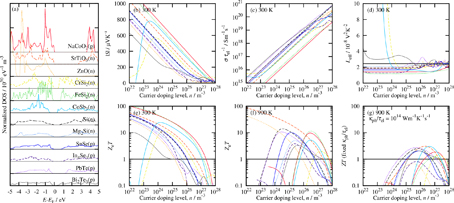Abstract
First-principles calculations were used to perform a cross-material investigation on the electronic structures of 13 parent compounds for thermoelectric materials. Boltzmann transport equations were used to calculate carrier doping level dependence of the Seebeck coefficient, electrical conductivity with respect to relaxation time, effective Lorenz numbers and the maximum possible thermoelectric figure of merit (ZeT) in the limit of zero phonon thermal conductivity. High ZeT was obtained only in semiconductors with finite band gaps. High ZeT for high doping level was achieved in compounds that had a steep density of states at the band edge. Calculations were combined with experimental transport properties to evaluate electron relaxation time of the samples. These analyses can be used to understand the nature of electron scattering mechanisms in specific thermoelectric materials and reduce the number of experiments required to develop new thermoelectric materials.

Fig. 1 (a) DOS of the 12 thermoelectric material parent compounds, normalized by unit cell volume. TB–mBJ was employed as the exchange-correlation potential. One grid along the vertical axes corresponds to normalized DOS of 10
30 eVm
−3. The letters in parentheses indicate the selected carrier types used for the transport calculations. (b)
n-dependence of the absolute Seebeck coefficients at 300 K. (c)
n-dependence of electrical conductivity (
σ) divided by
τel. (d)
n-dependence of effective Lorenz number. The black line indicates the theoretical value
L0 obtained from the free electron model. (e), (f)
n-dependence of
ZeT at (e) 300 K and (f) 900 K, assuming rigid crystal structures. (g)
n-dependence of
ZT at 900 K, assuming that
κph/
τel decreased to 10
14 Wm
−1K
−1s
−2 in all materials.
Fullsize Image



